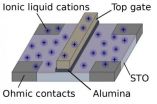(Press-News.org) As a heart fails, losing its ability to squeeze blood through the circulatory system, the body releases a neurohormone that interferes with the heart's best chance to improve contractility, a team of Temple University School of Medicine researchers show in a study published September 9th in the American Heart Association journal, Circulation.
The discovery reveals a promising target for the treatment of end-stage heart failure, and raises intriguing questions about why a drug used to treat some forms of end-stage heart failure improves symptoms but fails to extend lives or reduce hospitalization rates.
"This is a new mechanism that regulates cardiac function acutely," said Douglas G. Tilley, PhD, a pharmacology assistant professor at Temple University. "Its action hasn't really been appreciated before."
Tilley and Arthur M. Feldman, MD, PhD, Executive Dean and Professor of Medicine at Temple's School of Medicine, led the work examining the effect of arginine vasopressin (AVP), which heart failure patients overproduce. It's long been known that the higher a patient's AVP level, the greater the likelihood of death. But no one knew why.
Until now, it was believed vasopressin had two principal roles. It increased blood pressure by narrowing arteries, through its interaction with the vasopressin type 1A receptor, and it induced the kidneys to absorb more water and produce less urine, through the vasopressin type 2 receptor. But vasopressin's direct impact on the heart itself was unknown. "The common belief was that the vasopressin receptor in the heart was just not very important," Feldman said.
When researchers gave vasopressin in animal experiments, they dismissed any observed changes in heart function as a byproduct of vasopressin's action as a vasoconstrictor, which was making the heart work harder, Feldman said. The Temple researchers, by working with ex vivo hearts - that is, hearts removed from the body, with no vasculature - demonstrated that the effect of vasopressin type 1A receptor on cardiac function was independent of its role as a vasoconstrictor. In fact, it was preventing the heart from receiving important signals.
Vasopressin, it turns out, interferes with the body's attempt to rescue a failing heart, Feldman explained. As the heart muscle loses contractility, the body releases catecholamines - the same neurohormones that flood the blood stream in the face of danger. Catecholamines provide the juice for 'fight or flight' and make the heart work harder. Feldman and Tilley's research shows that vasopressin impairs the catecholamine receptors so that the heart never gets the message that would help its flaccid muscles contract more efficiently.
"This makes the heart vasopressin receptor, or some of the downstream signaling, a new and important target for therapies in patients with heart failure," Feldman said. If the V1 receptor could be blocked, or its signal interrupted, catecholamine signals could get through.
The discovery could be of critical importance to end-stage heart failure patients whose kidneys retain too much water, Tilley explained. To stop the kidneys' life-threatening water-retaining excess, these patients receive a drug, usually tolvaptan, that blocks only the vasopressin type 2 receptors in the kidneys. Once V2 receptors are blocked, the kidney stops retaining water. But V2-receptor blockers boost levels of circulating vasopressin throughout the body, including the heart. These elevated vasopressin levels may further interfere with catecholamine signaling in the heart.
"We're concerned that when using a V2R blocker in acute heart-failure patients who already have elevated AVP, you may enhance AVP levels in the heart, dampening contractile reserve, and negatively impacting survival of acute heart-failure patients," Tilley said.
"We think this is an explanation of why V2-selective vasopressin blockers don't really improve survival," Feldman said. "It would suggest what you really need to do is to combine a V1-block with a V2 blocker. We can't say what happens in humans; we haven't looked at that. But if what happens in a mouse model correlates with what goes on in humans, I think it warrants further investigation."
It also may explain the results of a study Feldman analyzed with another V2-blocker, lixivaptan. A partial summary of the results were published in April in Clinical Pharmacology & Therapeutics. In that study, some 400 patients were treated with lixivaptan or a placebo over 60 days. While the drug effectively lessened water retention, it failed to improve survival, cognitive function, and length of hospital stay. Further, more patients died in the treatment arm of the study than died in the placebo arm during the first 10 days of therapy, although the results never reached statistical significance. In all, 15 patients treated with lixivaptan died in the first 10 days, compared to four deaths in the placebo group. An FDA advisory committee reviewing the drug unanimously denied its approval.
"When we saw the trials with tolvaptan, and saw that it improved symptoms but didn't improve survival or hospital length-of-stay, we started to scratch our heads," Feldman said. "First we saw tolvaptan wasn't doing what we expected it to do, then lixivaptan actually caused harm. We thought maybe there is something going on with the vasopressin receptor in the heart that we weren't aware of."
The Circulation paper is the culmination of that work. In it, the researchers looked at the impact of vasopressin type 1 receptors in isolated cardiomyocytes, then in ex vivo hearts, and finally in a mouse model of heart failure.
INFORMATION:
Also involved in the research are Weizhong Zhu, MD, Valerie D. Myers, MsC, Jianlliang Song, MD, PhD, Constantine D. Troupes, BScH, Ryan C. Coleman, BScH, Larry A. Barr, PhD., Catherine A. Makarewich, PhD, and Steven R. Houser, PhD, from the Temple Cardiovascular Research Center of Temple University School of Medicine; Erhe Gao, MD, Rhonda L. Carter, BS, Laurel A. Grisanti, PhD, Walter J. Koch, PhD, and Joseph Y. Cheung, MD, PhD, from the Center for Translational Medicine at Temple University School of Medicine; Daohai Yu, PhD, Department of Clinical Sciences at Temple University School of Medicine; and Xue Li, MD, from the Division of Cardiology, Fourth Military Medical University, Xian, China.
The work was supported by National Institutes of Health grants HL105414, HL091799, HL074854 and HL033921; a Pennsylvania Health Research Formula Fund (SAP#4100060220); and American Heart Association postdoctoral and predoctoral fellowships.
Temple University researchers identify a new target for treating heart failure
2014-09-09
ELSE PRESS RELEASES FROM THIS DATE:
UT Southwestern expert co-chairs national team to develop first comprehensive guidelines for management of sickle cell disease
2014-09-09
DALLAS – September 9, 2014– The National Heart, Lung, and Blood Institute (NHLBI) has released the first comprehensive, evidence-based guidelines for management of sickle cell disease from birth to end of life, based on recommendations developed by a nationwide team of experts co-chaired by a UT Southwestern Medical Center hematologist.
Appearing today in JAMA, the guidelines are intended for general use by pediatricians, physicians treating adults, hematologists, emergency room personnel, hospitalists, and other health care providers. The new management guidelines consist ...
Nearly 1 in 5 new nurses leave first job within a year, according to RN survey
2014-09-09
Turnover of registered nurses (RNs) is an important and widely used measure in analyzing the health care workforce. It's used to project the job market for nurses (based on availability of jobs) and can also be considered an indicator of whether a health care organization has a good working environment.
A study in the current issue of Policy, Politics & Nursing Practice reveals that an estimated 17.5 percent of newly-licensed RNs leave their first nursing job within the first year and one in three (33.5%) leave within two years. The researchers found that turnover for ...
Less effective DNA repair process takes over as mice age
2014-09-09
As we and other vertebrates age, our DNA accumulates mutations and becomes rearranged, which may result in a variety of age-related illnesses, including cancers. Biologists Vera Gorbunova and Andei Seluanov have now discovered one reason for the increasing DNA damage: the primary repair process begins to fail with increasing age and is replaced by one that is less accurate.
The findings have been published in the journal PLOS Genetics.
"Scientists have had limited tools to accurately study how DNA repair changes with age," said Gorbunova. "We are now able to measure ...
Discovery paves the way for a new generation of chemotherapies
2014-09-09
A new mechanism to inhibit proteasomes, protein complexes that are a target for cancer therapy, is the topic of an article published in the journal Chemistry & Biology. The first author of the study is Daniela Trivella, researcher at the Brazilian Biosciences National Laboratory at the Brazilian Center for Research in Energy and Materials (LNBio/CNPEM).
The findings of the study, conducted with FAPESP support in partnership with researchers from the University of California in San Diego, United States, and at the Technische Universität München, in Germany, are paving the ...
Two-dimensional electron liquids
2014-09-09
Truly two-dimensional objects are rare. Even a thin piece of paper is trillions of atoms thick. When physicists do succeed in producing 2D systems, quantum interactions can lead to new phenomena and Nobel prizes. Two examples: graphene---single-atom-thick sheets of carbon atoms---has unique mechanical, electrical, and optical properties; and two-dimensional electron gases (2DEG)---planar collections of electrons supported at the interface between certain semiconductors such as gallium arsenide---allow the observation of such emergent behaviors as the quantum Hall effect ...
Rice wireless experts tap unused TV spectrum
2014-09-09
Rice University wireless researchers have found a way to make the most of the unused UHF TV spectrum by serving up fat streams of data over wireless hotspots that could stretch for miles.
In a presentation today at the Association for Computing Machinery's MobiCom 2014 conference in Maui, Hawaii, researchers from Rice's Wireless Network Group will unveil a multiuser, multiantenna transmission scheme for UHF, a portion of the radio spectrum that is traditionally reserved for television broadcasts.
"The holy grail of wireless communications is to go both fast and far," ...
Globalization threatens benefits of an African 'green revolution'
2014-09-09
A prospective "green revolution" in Africa could boost land use and carbon emissions globally, according to a study co-authored by a University of British Columbia researcher.
The term "green revolution" typically describes the use of agricultural innovations – such as the development of new seeds – to increase yields, particularly in developing countries.
Past green revolutions in Asia, Latin America and the Middle East have spared land and carbon dioxide emissions. However, in an increasingly globalized economy, an African green revolution could lead to opposite outcomes, ...
This week from AGU: Global food trade, weather forecasting, aerosol transport
2014-09-09
From AGU's blogs: Global food trade may not meet all future demand, new study indicates
As the world population continues to grow, by about 1 billion people every 12 to 14 years since the 1960s, the global food supply may not meet escalating demand – particularly for agriculturally poor countries in arid to semi-arid regions, such as Africa's Sahel, that already depend on imports for much of their food supply, according to a new study published online in the American Geophysical Union journal, Earth's Future.
From this week's Eos: Next-Generation Forecasting of High-Impact ...
Kessler Foundation multiple sclerosis researchers find role for working memory in cognitive reserve
2014-09-09
West Orange, NJ. September 9, 2014. Kessler Foundation scientists have shown that working memory may be an underlying mechanism of cognitive reserve in multiple sclerosis (MS). This finding informs the relationships between working memory, intellectual enrichment (the proxy measure for cognitive reserve) and long-term memory in this population. "Working memory mediates the relationship between intellectual enrichment and long-term memory in multiple sclerosis: An exploratory analysis of cognitive reserve" (doi: 10.1017/S1355617714000630) was published online ahead of ...
Proactive office ergonomics can increase job satisfaction and employee retention
2014-09-09
As the amount of time employees spend at their desks increases, so does musculoskeletal discomfort and other health issues associated with the office environment. Although office ergonomics training programs have been shown to improve employee well-being and productivity, in many cases training occurs only after complaints are logged. New research to be presented at the HFES 2014 Annual Meeting in Chicago demonstrates that a comprehensive and proactive workplace ergonomics program can help to prevent discomfort and injury.
Alan Hedge, coauthor of "Proactive Office Ergonomics ...



